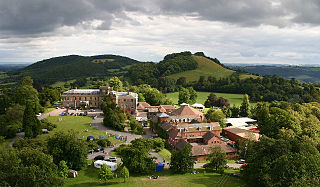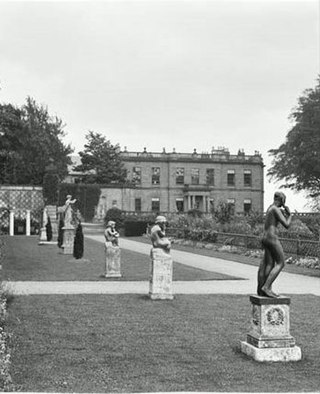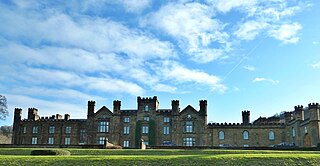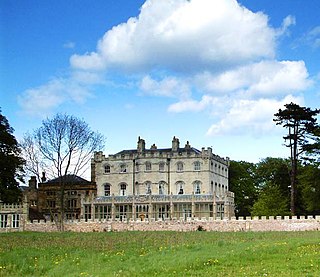Castle Eden is a village in County Durham, in England. The population of the parish at the 2011 census was 642. It is situated a short distance to the south of Peterlee, Wingate, Hutton Henry, the A19 and Castle Eden Dene. The village is famous for the former Castle Eden Brewery which was home of the famous Castle Eden Ale; most of it was demolished in 2003 for a new housing estate and only the main front building remains today. This is a listed building and is now managed office space with a popular Italian restaurant. The A19 used to run through the village until it was bypassed in the 1970s. The deep and impressive nearby dene extends all the way to the sea, and its many yew trees are a particular feature where they find the dolomite soil advantageous.

Hylton Castle is a stone castle in the North Hylton area of Sunderland, Tyne and Wear, England. Originally built from wood by the Hilton family shortly after the Norman Conquest in 1066, it was later rebuilt in stone in the late 14th to early 15th century. The castle underwent major changes to its interior and exterior in the 18th century and it remained the principal seat of the Hylton family until the death of the last Baron in 1746. It was then Gothicised but neglected until 1812, when it was revitalised by a new owner. Standing empty again until the 1840s, it was briefly used as a school until it was purchased again in 1862. The site passed to a local coal company in the early 20th century and was taken over by the state in 1950.

Capesthorne Hall is a country house near the village of Siddington, Cheshire, England. The house and its private chapel were built in the early 18th century, replacing an earlier hall and chapel nearby. They were built to Neoclassical designs by William Smith and (probably) his son Francis. Later in the 18th century, the house was extended by the addition of an orangery and a drawing room. In the 1830s the house was remodelled by Edward Blore; the work included the addition of an extension and a frontage in Jacobean style, and joining the central block to the service wings. In about 1837 the orangery was replaced by a large conservatory designed by Joseph Paxton. In 1861 the main part of the house was virtually destroyed by fire. It was rebuilt by Anthony Salvin, who generally followed Blore's designs but made modifications to the front, rebuilt the back of the house in Jacobean style, and altered the interior. There were further alterations later in the 19th century, including remodelling of the Saloon. During the Second World War the hall was used by the Red Cross, but subsequent deterioration prompted a restoration.

A gatehouse is a type of fortified gateway, an entry control point building, enclosing or accompanying a gateway for a town, religious house, castle, manor house, or other fortification building of importance. Gatehouses are typically the most heavily armed section of a fortification, to compensate for being structurally the weakest and the most probable attack point by an enemy. There are numerous surviving examples in France, Austria, Germany, England and Japan.

Wilton is a small village in Redcar and Cleveland, North Yorkshire, England. In 1951 the parish had a population of 958.

Tatton Hall is a country house in Tatton Park near Knutsford, Cheshire, England. It is designated as a Grade I listed building and is open to the public.

Abberley Hall is a country house in the north-west of the county of Worcestershire, England. The present Italianate house is the work of Samuel Daukes and dates from 1846 to 1849. Since 1916 it has been occupied by Abberley Hall School. It is a Grade II* listed building. The gardens are listed as Grade II on the English Heritage Register of Historic Parks and Gardens of Special Historic Interest in England. In the area close to Stourport-on-Severn there are several large manor and country houses, among which Witley Court, Astley Hall, Pool House, Areley Hall, Hartlebury Castle and Abberley Hall are particularly significant.
This is a list of the High Sheriffs of County Durham, England.

Leigh Court is a country house which is a Grade II* listed building in Abbots Leigh, Somerset, England. The grounds and park are listed, Grade II, on the Register of Historic Parks and Gardens of special historic interest in England.

Caverswall Castle is a privately owned early-17th-century English mansion built in a castellar style upon the foundations and within the walls of a 13th-century castle, in Caverswall, Staffordshire. It is a Grade I listed building. The castle is large, with a floor area of 2,030 square yards (1,700 m2).
Ladbroke Hall is an 18th-century English country house at Ladbroke, near Southam, Warwickshire. It is a Grade II listed building and is now divided into apartments.

Whitworth Hall which stands in Whitworth Hall Country Park, near Spennymoor, County Durham England, is a country house, formerly the home of the Shafto family and now a hotel. It is a listed building.

Beamish Hall is a mid-18th-century country house, now converted to a hotel, which stands in 24 acres (97,000 m2) of grounds near the town of Stanley, County Durham. It is a Grade II* listed building.

Windlestone Hall is a mid-16th century Elizabethan country house, heavily rebuilt in 1821 to form a Greek revival stately home, situated near Rushyford, County Durham, England. The Hall sits within 400 acres of designed parkland. It is a Grade II* Listed building. As of 2022 it is back in private family ownership, with the surrounding estate maintained and conserved by a dedicated heritage charitable trust.

Wilton Castle is an early 19th-century mansion, built on the site of a medieval castle, now converted into residential apartments, situated at Wilton, in Redcar and Cleveland, North Yorkshire, England. It is a Grade II listed building.

Gisborough Hall is a 19th-century mansion house, now a hotel, at Guisborough, Redcar and Cleveland, England. It is a Grade II listed building.

Parwich Hall is a privately owned 18th-century mansion house at Parwich, near Ashbourne, Derbyshire Dales. It is a Grade II* listed building.

Biddick Hall is a small privately owned 18th-century country mansion at Bournmoor, County Durham, near the City of Sunderland and Chester-le-Street. It is a Grade I listed building and the home of the Lambton family.

Colonel Rowland Burdon, VD, DL, JP was an English landowner and Conservative Party politician from County Durham. He sat in the House of Commons from 1918 to 1922.

Hardwick Hall in Sedgefield, County Durham is a building of historical significance and is a Grade II listed building on the English Heritage Register. A major part of it was built in the late 1700s but it is possible that some of it dates from about 1634. It was the residence for many notable people for two centuries. It is now a hotel which provides accommodation and restaurant services and caters for special events particularly weddings.

















